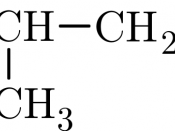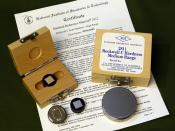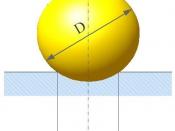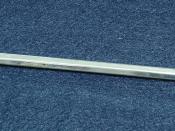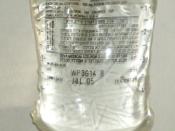Unknown Polymer Identification By Amar Singh Abstract The main purpose of this experiment is to find out the unknown polymer to be used to replace a machine part. The main experimental procedure is to compare the unknown polymer with the known polymers available in the organization and thus conclude which unknown matches the most with the given polymer. Testing the density of the materials and their hardeness does this. After doing so and plotting the results in a flow chart, it could be concluded that the unknown matched the description of Polystyrene based on the density and hardness tests.
Introduction The experiment titled Unknown Polymer Identification was conducted on Friday July 20th. The main purpose of the experiment was to find out the replacement part for a specialty machine. For doing so, one has to identify the polymer for the part from the given materials present in the company itself.
Background The main significance of the experiment is to find out the right material for the machine in use. Developing the right procedure for finding out the given part is the challenging part of this experiment. The important properties of the materials that are given are as follows A. Polyethylene is known to be having a low coefficient of friction. It is tough, has low strength and offers poor resistant to weathering. It is also chemically resistant and electrically insulated material. It is used in battery parts, ice trays, film wrapping materials, toys, tumblers etc.
B. Polypropylene is resistant to heat distortion, has excellent electrical properties and fatigue strength, it is chemically inert, offers little resistance to UV light and is relatively inexpensive. It is used in wall tile, battery cases, lightening panels and appliance housings.
C. Polycarbonate is chemically resistant, has low water absorption, is transparent, has good impact resistance and ductility and is dimensionally stable. It is used in lenses, safety helmets, light globes and base for photographic films.
D. Polyvinlychloride has a general-purpose use, is flexible with plasticizers, is low cost and is susceptible to heat distortion. It is used in floor covering, pipe and electrical wire insulation.
Experimental Procedure The experimental procedure for this experiment is very simple and consists of two parts. The first part is testing the density of the materials by immersing them first in water (1.00gms/cm3) and then in saline solution (1.05 gms/cm3 ). The results are noted. The next step includes testing the material for hardness by using the hardness testing device and similarly the result for this test are also noted down.
Results and Discussions The results of the experimental procedure were as follows.
The results from the flow chart show that the unknown material is Polystyrene. This result is based on the fact that both Polystyrene and the unknown show similar results in the density and the hardness tests. i.e. both of them float in saline solution and both have a hardness tests of 57 and 54 respectively.
Conclusion Based on the above results, it can be concluded that the unknown material is polystyrene which should be used for making the part of the machine.
Appendix Polymer Density in water Density in saline Hardness test Polyethylene Floated N/A N/A Polypropylene Floated N/A N/A Polystyrene Sank Floated 57 Polycarbonate Sank Sank N/A Poly-Vinyl chloride Sank Sank N/A Unknown Sank Floated N/A
